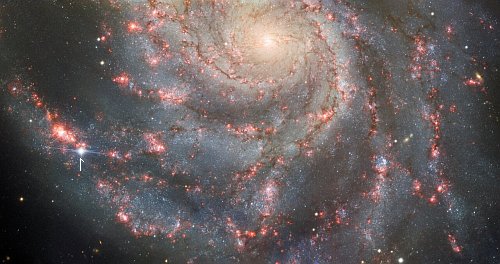Gemini telescope in Hawaii fixed, captures nearby supernova
The Gemini telescope in Hawaii, which was damaged in 2022 during normal maintenance operations, has now been fixed and resumed observations, beginning with a spectacular image of the newly discovered supernova in the Pinwheel Galaxy, only 20 million light years away.
The Gemini North telescope, one half of the International Gemini Observatory operated by NSF’s NOIRLab, has returned from a seven-month hiatus literally with a bang, as it has captured the spectacular aftermath of a supernova, a massive star that exploded in the large, face-on, spiral Pinwheel Galaxy (Messier 101). The supernova, named SN 2023ixf [as indicated by the arrow], was discovered on 19 May by amateur astronomer Koichi Itagaki.
Since its discovery, observers around the globe have pointed their telescopes toward Messier 101 to get a look at the burst of light. Over the coming months, Gemini North will allow astronomers to study how the light from the supernova fades and how its spectrum evolves over time, helping astronomers better understand the physics of such explosions.
As one of the closest supernova to occur in years, SN 2023ixf has become a major target by astronomers. This type of supernova signals the collapse and death of a star 8 to 10 times the mass of the Sun. Since the life cycle of such massive stars is not yet fully understood, this nearby supernova provides a great opportunity for astronomers to learn more.
On Christmas Eve 1968 three Americans became the first humans to visit another world. What they did to celebrate was unexpected and profound, and will be remembered throughout all human history. Genesis: the Story of Apollo 8, Robert Zimmerman's classic history of humanity's first journey to another world, tells that story, and it is now available as both an ebook and an audiobook, both with a foreword by Valerie Anders and a new introduction by Robert Zimmerman.
The print edition can be purchased at Amazon or from any other book seller. If you want an autographed copy the price is $60 for the hardback and $45 for the paperback, plus $8 shipping for each. Go here for purchasing details. The ebook is available everywhere for $5.99 (before discount) at amazon, or direct from my ebook publisher, ebookit. If you buy it from ebookit you don't support the big tech companies and the author gets a bigger cut much sooner.
The audiobook is also available at all these vendors, and is also free with a 30-day trial membership to Audible.
"Not simply about one mission, [Genesis] is also the history of America's quest for the moon... Zimmerman has done a masterful job of tying disparate events together into a solid account of one of America's greatest human triumphs."--San Antonio Express-News
The Gemini telescope in Hawaii, which was damaged in 2022 during normal maintenance operations, has now been fixed and resumed observations, beginning with a spectacular image of the newly discovered supernova in the Pinwheel Galaxy, only 20 million light years away.
The Gemini North telescope, one half of the International Gemini Observatory operated by NSF’s NOIRLab, has returned from a seven-month hiatus literally with a bang, as it has captured the spectacular aftermath of a supernova, a massive star that exploded in the large, face-on, spiral Pinwheel Galaxy (Messier 101). The supernova, named SN 2023ixf [as indicated by the arrow], was discovered on 19 May by amateur astronomer Koichi Itagaki.
Since its discovery, observers around the globe have pointed their telescopes toward Messier 101 to get a look at the burst of light. Over the coming months, Gemini North will allow astronomers to study how the light from the supernova fades and how its spectrum evolves over time, helping astronomers better understand the physics of such explosions.
As one of the closest supernova to occur in years, SN 2023ixf has become a major target by astronomers. This type of supernova signals the collapse and death of a star 8 to 10 times the mass of the Sun. Since the life cycle of such massive stars is not yet fully understood, this nearby supernova provides a great opportunity for astronomers to learn more.
On Christmas Eve 1968 three Americans became the first humans to visit another world. What they did to celebrate was unexpected and profound, and will be remembered throughout all human history. Genesis: the Story of Apollo 8, Robert Zimmerman's classic history of humanity's first journey to another world, tells that story, and it is now available as both an ebook and an audiobook, both with a foreword by Valerie Anders and a new introduction by Robert Zimmerman.
The print edition can be purchased at Amazon or from any other book seller. If you want an autographed copy the price is $60 for the hardback and $45 for the paperback, plus $8 shipping for each. Go here for purchasing details. The ebook is available everywhere for $5.99 (before discount) at amazon, or direct from my ebook publisher, ebookit. If you buy it from ebookit you don't support the big tech companies and the author gets a bigger cut much sooner.
The audiobook is also available at all these vendors, and is also free with a 30-day trial membership to Audible.
"Not simply about one mission, [Genesis] is also the history of America's quest for the moon... Zimmerman has done a masterful job of tying disparate events together into a solid account of one of America's greatest human triumphs."--San Antonio Express-News



I still have a bit of cognitive dissonance when astronomers refer to something in another galaxy as “nearby.” Why it’s ONLY 20 million light years away! That a mere 200 trillion kilometers, give or take.
Watching the Distant Planet Krypton Exploding and a wee little rocket heading our way